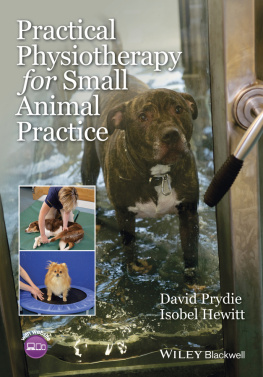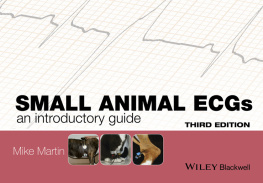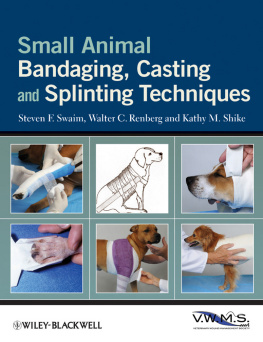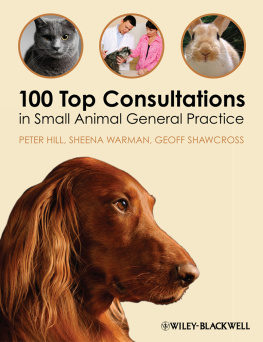Prydie David - Practical Physiotherapy for Small Animal Practice
Here you can read online Prydie David - Practical Physiotherapy for Small Animal Practice full text of the book (entire story) in english for free. Download pdf and epub, get meaning, cover and reviews about this ebook. year: 2015, publisher: John Wiley & Sons, Incorporated, genre: Romance novel. Description of the work, (preface) as well as reviews are available. Best literature library LitArk.com created for fans of good reading and offers a wide selection of genres:
Romance novel
Science fiction
Adventure
Detective
Science
History
Home and family
Prose
Art
Politics
Computer
Non-fiction
Religion
Business
Children
Humor
Choose a favorite category and find really read worthwhile books. Enjoy immersion in the world of imagination, feel the emotions of the characters or learn something new for yourself, make an fascinating discovery.
- Book:Practical Physiotherapy for Small Animal Practice
- Author:
- Publisher:John Wiley & Sons, Incorporated
- Genre:
- Year:2015
- Rating:5 / 5
- Favourites:Add to favourites
- Your mark:
- 100
- 1
- 2
- 3
- 4
- 5
Practical Physiotherapy for Small Animal Practice: summary, description and annotation
We offer to read an annotation, description, summary or preface (depends on what the author of the book "Practical Physiotherapy for Small Animal Practice" wrote himself). If you haven't found the necessary information about the book — write in the comments, we will try to find it.
Practical Physiotherapy for Small Animal Practice — read online for free the complete book (whole text) full work
Below is the text of the book, divided by pages. System saving the place of the last page read, allows you to conveniently read the book "Practical Physiotherapy for Small Animal Practice" online for free, without having to search again every time where you left off. Put a bookmark, and you can go to the page where you finished reading at any time.
Font size:
Interval:
Bookmark:

This edition first published 2015 2015 by John Wiley & Sons, Ltd
Registered office: John Wiley & Sons, Ltd, The Atrium, Southern Gate, Chichester, West Sussex, PO19 8SQ, UK
Editorial offices: 9600 Garsington Road, Oxford, OX4 2DQ, UK
The Atrium, Southern Gate, Chichester, West Sussex, PO19 8SQ, UK
1606 Golden Aspen Drive, Suites 103 and 104, Ames, Iowa 50010, USA
For details of our global editorial offices, for customer services and for information about how to apply for permission to reuse the copyright material in this book please see our website at www.wiley.com/wiley-blackwell
The right of the author to be identified as the author of this work has been asserted in accordance with the UK Copyright, Designs and Patents Act 1988.
All rights reserved. No part of this publication may be reproduced, stored in a retrieval system, or transmitted, in any form or by any means, electronic, mechanical, photocopying, recording or otherwise, except as permitted by the UK Copyright, Designs and Patents Act 1988, without the prior permission of the publisher.
Designations used by companies to distinguish their products are often claimed as trademarks. All brand names and product names used in this book are trade names, service marks, trademarks or registered trademarks of their respective owners. The publisher is not associated with any product or vendor mentioned in this book. It is sold on the understanding that the publisher is not engaged in rendering professional services. If professional advice or other expert assistance is required, the services of a competent professional should be sought.
The contents of this work are intended to further general scientific research, understanding, and discussion only and are not intended and should not be relied upon as recommending or promoting a specific method, diagnosis, or treatment by health science practitioners for any particular patient. The publisher and the author make no representations or warranties with respect to the accuracy or completeness of the contents of this work and specifically disclaim all warranties, including without limitation any implied warranties of fitness for a particular purpose. In view of ongoing research, equipment modifications, changes in governmental regulations, and the constant flow of information relating to the use of medicines, equipment, and devices, the reader is urged to review and evaluate the information provided in the package insert or instructions for each medicine, equipment, or device for, among other things, any changes in the instructions or indication of usage and for added warnings and precautions. Readers should consult with a specialist where appropriate. The fact that an organization or Website is referred to in this work as a citation and/or a potential source of further information does not mean that the author or the publisher endorses the information the organization or Website may provide or recommendations it may make. Further, readers should be aware that Internet Websites listed in this work may have changed or disappeared between when this work was written and when it is read. No warranty may be created or extended by any promotional statements for this work. Neither the publisher nor the author shall be liable for any damages arising herefrom.
Library of Congress Cataloging-in-Publication Data
Prydie, David, author.
Practical physiotherapy for small animal practice / David Prydie, Isobel Hewitt.
p. ; cm.
Includes bibliographical references and index.
ISBN 978-1-118-66154-3 (paper)
I. Hewitt, Isobel, author. II. Title.
[DNLM: 1. Physical Therapy Modalitiesveterinary. 2. Hospitals, Animalstandards. 3. Musculoskeletal Diseasesveterinary. 4. Physical Therapy Specialtymethods. SF 925]
SF925.P78 2015
636.089582dc23
2015018215
A catalogue record for this book is available from the British Library.
Wiley also publishes its books in a variety of electronic formats. Some content that appears in print may not be available in electronic books.
DAVID PRYDIE
BVMS, CertSAO, CCRT, MRCVS
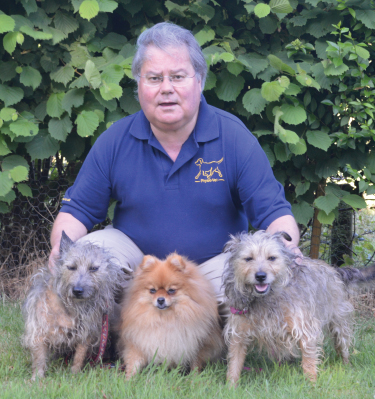
David Prydie with his two terrier crosses Spud and Sprout, and his Pomeranian, Mr. Darcy.
David graduated from Glasgow veterinary school in 1981 and obtained his certificate in Small Animal Orthopaedics in 1991. He has worked in first opinion and orthopaedic referral practice throughout the United Kingdom. In 2009, David obtained his Certificate in Canine Rehabilitation from The Canine Rehabilitation Institute, USA. He currently owns and runs Physio-Vet, a dedicated small animal physiotherapy practice in Cheshire, Crewe, UK (www.physio-vet.co.uk). David has lectured on animal rehabilitation and physiotherapy at many national and international conferences. His particular interests are canine sports medicine and the management of chronic musculoskeletal diseases, such as canine osteoarthritis and degenerative myelopathies.
Isobel Hewitt
BSc (Hons,) MSc, ACPAT (Cat A)
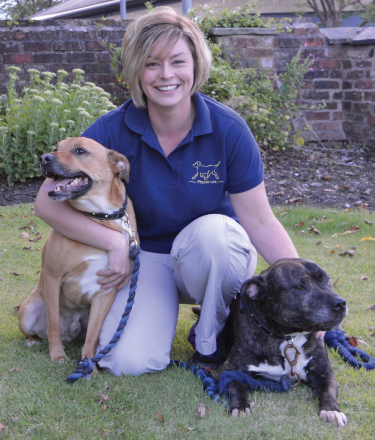
Isobel Hewitt with her Staffordshire Bull Terrier Wilson and her Staffy Cross Marley.
Isobel graduated in physiotherapy in 2003 from Sheffield Hallam University. She is a Chartered Physiotherapist and has many years of experience as a human physiotherapist. She has her own human physiotherapy practice specialising in musculoskeletal physiotherapy. In 2009, she completed her MSc in Animal Physiotherapy from the Royal Veterinary College, London. She has worked at Physio-Vet since its opening. Her special interests are proprioceptive retraining, orthotic and splinting devices and functional rehabilitation for small animals.
She is a category A member of ACPAT (Association of Chartered Physiotherapists in Animal Therapy).
Physiotherapy on dogs and cats has been practiced for well over 25 years. The benefits for patients and practices have been clearly demonstrated. This said, there is still little undergraduate training and the majority of practices offer little or no physiotherapy. A lot of people within the profession are aware of physiotherapy but are not quite sure what it involves.
This textbook is aimed at veterinary surgeons, veterinary nurses and others who want to know more about physiotherapy in small animals. These people may be considering introducing physiotherapy to their practice or considering a training course. We have tried to explain what physiotherapy is and how it is of benefit to the animal, owner and practice. For those who want more details and evidence of the benefits of physiotherapy in small animals, please refer to the Further Readings section (Appendix 3).
We have written this textbook from a practical point of view with advice on selection of equipment, examination, treatment protocols and charging. Our writings and recommendations are based on the cases that we see and treat on a daily basis. We have included chapters on healing and anatomy as they form the basis of treatment protocols and examination. The textbook is by no means definitive and it is important for each therapist to develop his/her own examination and treatment protocols. However, this can only be done with experience of cases. This textbook offers a starting place that can then be adapted and built upon.
David Prydie
Font size:
Interval:
Bookmark:
Similar books «Practical Physiotherapy for Small Animal Practice»
Look at similar books to Practical Physiotherapy for Small Animal Practice. We have selected literature similar in name and meaning in the hope of providing readers with more options to find new, interesting, not yet read works.
Discussion, reviews of the book Practical Physiotherapy for Small Animal Practice and just readers' own opinions. Leave your comments, write what you think about the work, its meaning or the main characters. Specify what exactly you liked and what you didn't like, and why you think so.

